ABS AUDI Q5 2016 Owner's Manual
[x] Cancel search | Manufacturer: AUDI, Model Year: 2016, Model line: Q5, Model: AUDI Q5 2016Pages: 300, PDF Size: 75.02 MB
Page 212 of 300
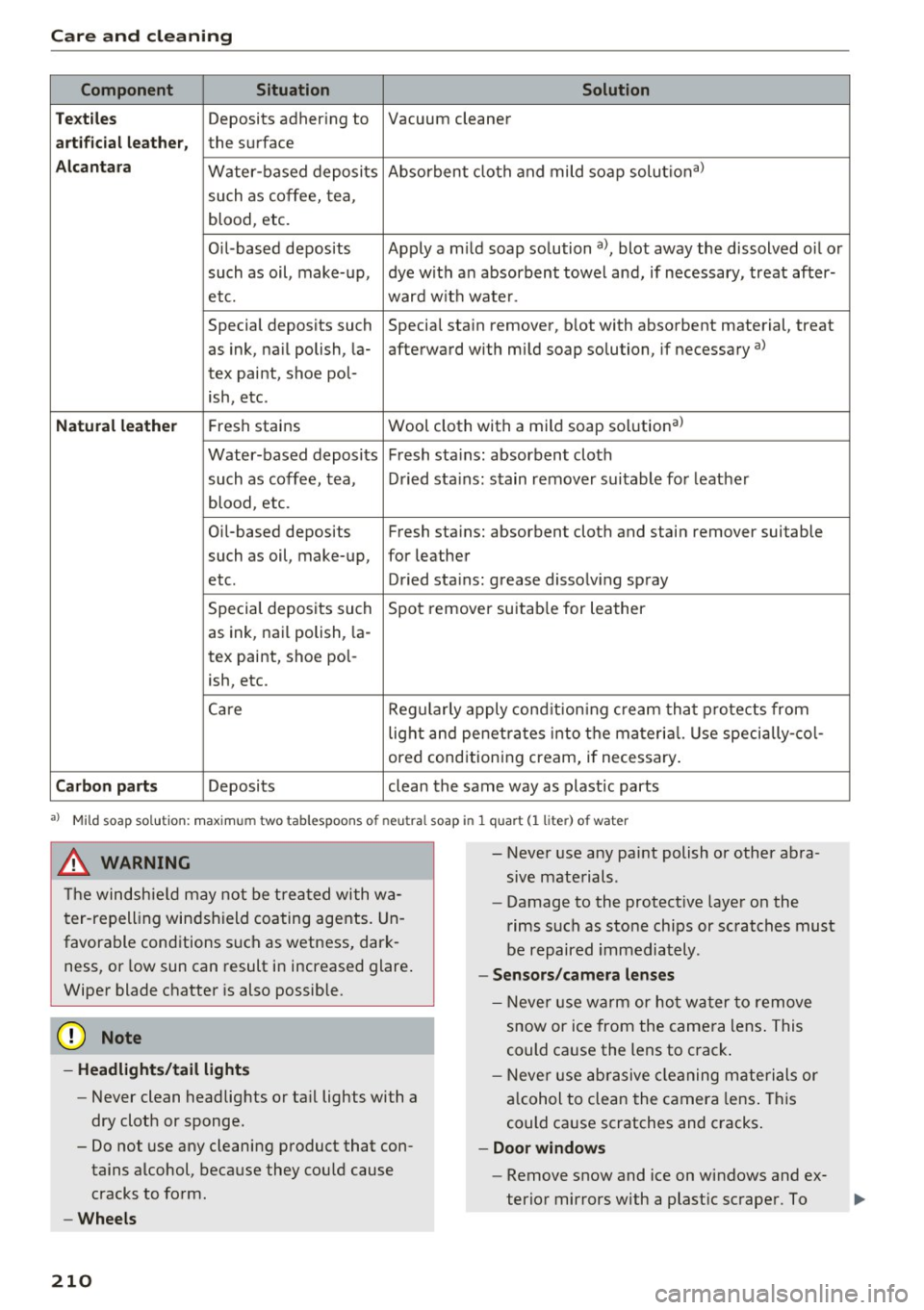
Care and cleaning
Component Situation Solution
Te xtil es
Deposits adhering to Vacuum cleaner
a rt ifici al le ather , the surface
Alcant ara Water-based deposits Absorben
t cloth and mild soap solutiona>
such as coffee, tea,
blood, etc.
O il-based deposits Apply a m ild soap solution a), blot away the dissolved oil or
such as oil, make-up, dye with an absorbent towel and, if necessary, treat after-
etc. ward wit h water.
Special deposits such Special stain remover, b lot with absorbent material, treat
as ink, na il polish, la- afterward with mild soap solution, if necessary a)
tex paint, shoe pol-
ish, etc.
Natural leather Fresh stains Wool cloth with a mild soap so
lutiona)
Water-based deposits Fresh sta ins : absorbent cloth
such as coffee, tea, Dried sta ins: stain remover suitable fo r leather
blood, etc.
Oil-based deposits Fresh stains: absorbent cloth and stain remover suitable
such as oil, make-up, for leather
etc. Dried sta ins : grease dissolv ing spray
Special deposits such Spot remover suitab le for leather
as ink, nai l polish, la -
tex paint, shoe pol-
ish, etc.
Ca re Regularly apply cond ition ing cream that protects from
light and penet rates into the materia l. Use specia lly-co l-
ored conditioning cream, if necessary.
Carbon parts Deposits clean the same way as plastic parts
a) Mild soap solution: maximum two tablespoons of neutral soap in 1 quart (l liter) of water
_& WARNING
The windshie ld may not be trea ted with wa
ter-repelling windshield coating agents. Un
favorable conditions s uch as wetness, dark
ness, or low sun can result in increased glare .
Wiper blade chatter is also possible.
(D Note
- Headlights/tail light s
-Never clean headlights or tail lights with a
dry cloth or sponge.
- Do not use any cleaning product that con
tains alcohol, because they could cause
cracks to form.
- Wheels
210
-
- Never use any paint polish or other abra
sive materials.
- Damage to the protect ive layer on the
rims such as stone chips or scratches must
be repaired immediately.
- Sensors /camera lenses
- Neve r use wa rm or ho t wa ter to remove
snow or ice from the camera lens . This
could cause the lens to crack .
- N eve r use ab rasive cleaning materials or
a lcohol to clea n the camera lens . This
could cause scratches and cracks .
-Doo r window s
-Remove snow and ice on windows and ex-
terior mirrors with a plast ic scraper. To
Page 231 of 300
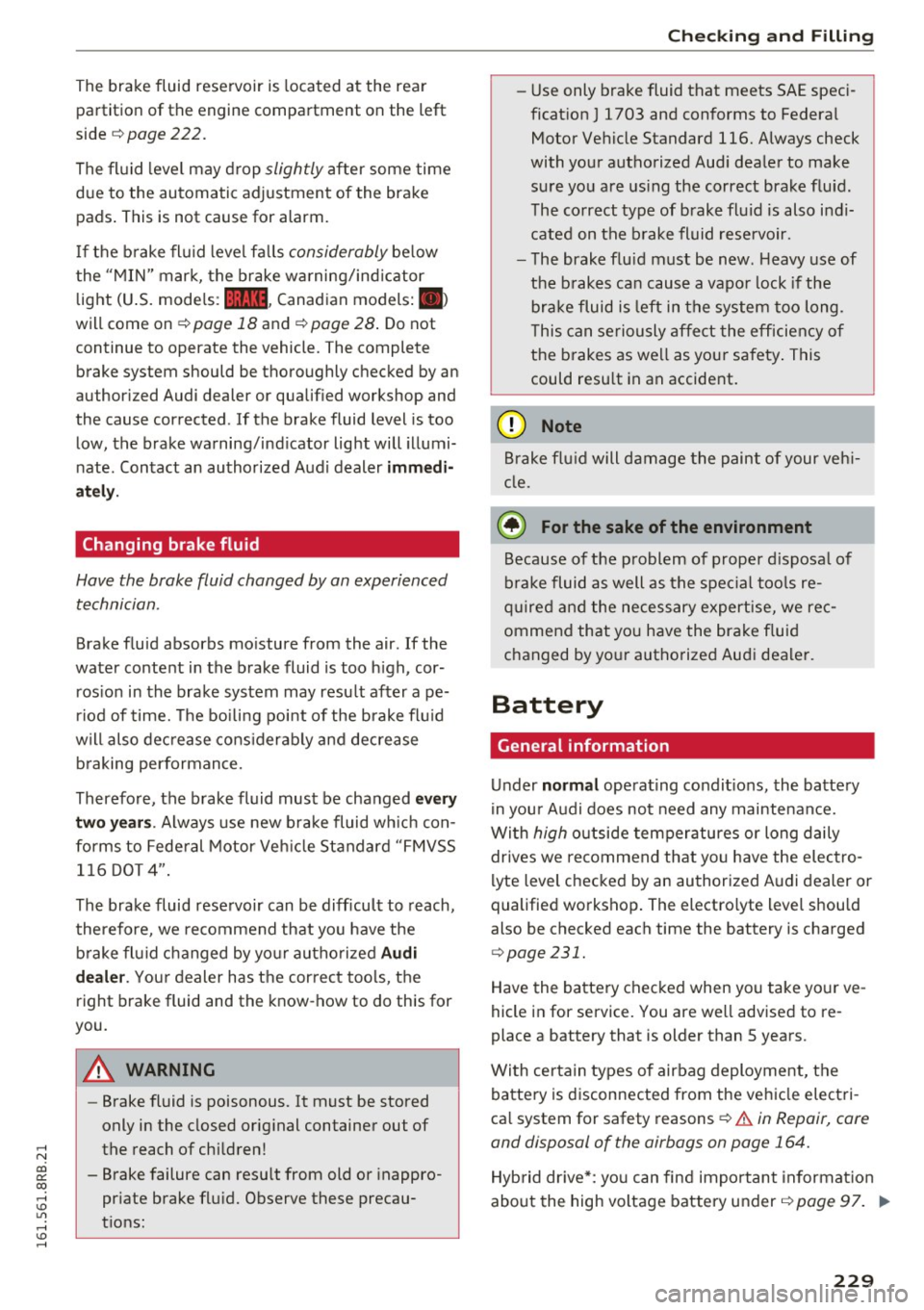
,....,
N
co
er::
co
,....,
partition of the engine compartment on the left
side ¢
page 222.
The fl uid level may drop slightly after some time
due to the automatic adjustment of the brake
pads . This is not cause for alarm.
I f the b rake fl uid level fa lls
considerably be low
the "MIN" mark, the brake wa rning/ind icator
light (U .S. mode ls:
1111 , Canadian models:.)
will come on¢
page 18 and ¢ page 28 . Do not
continue to operate the vehicle. The complete brake system should be thoroughly checked by an
author ized Audi dealer or qualified workshop and
the cause corrected . If the brake fluid level is too
low, the brake warning/ind icator light will illumi
nate. Contact an authorized Audi dealer
immedi
a te ly.
Changing brake fluid
Have the brake fluid changed by an experienced technician.
Brake fluid absorbs mo isture from the air. If the
water conte nt in the brake fluid is too h igh, cor
ros ion in the brake system may resu lt after ape
riod of time. The boiling poi nt of the brake flu id
will also dec rease cons iderably and decrease
braking pe rformance.
Therefore, the b rake fluid must be changed
e ve ry
two year s.
Always use new b rake fluid wh ich con
forms to Fede ral Motor Veh icle St andard "FMVSS
116 DOT 4".
The brake fluid reservoir can be diff icult to reach,
therefore, we re commend that yo u have the
b rake fl uid changed by yo ur autho rized
Audi
deal er.
Your dealer has the cor rect too ls, the
right brake fluid and the know -how to do this for
you.
A WARNING
- Brake fluid is poisonous. It must be stored
only in the closed original container out of
the reach of chi ldren!
- B rake failure can resu lt from old or inappro
pr iate brake flu id. Observe these precau
t io ns:
Ch eck ing and Filling
-Use only brake fluid that meets SAE speci
ficat ion
J 1703 and conforms to Federal
Motor Vehicle Standard 116. Always check
with your authorized Aud i dealer to make
sure you are us ing the correct brake fluid .
The co rrect type of brake flu id is also i ndi
cated on the b rake fluid reservoir.
- The brake flu id must be new. Heavy use of
the b rakes can cause a vapo r lock if the
bra ke fluid is left in the system too long.
T his can se riously affe ct the efficiency of
t h e b rakes as we ll as you r safety . This
could resu lt in an accident.
(D Note
B rake flu id will damage the paint of your ve h i
cle.
@) For the sake of the environment
Because of the p roblem of proper d isposa l of
brake fluid as well as the spec ial too ls re
q uire d and the necessary expertise, we rec
ommend that yo u have the bra ke fluid
c hanged by yo ur authorize d Au di dealer.
Battery
General information
Under normal ope rat ing condit ions, the batte ry
in you r A udi does not need any mainte nance.
Wi th
high o utside temperatures or long daily
drives we recommend that yo u have the elec tro
lyte level checked by an authorized A udi dealer or
qualified workshop . The electro lyte level should
also be checked each time the battery is charged
~ page 231.
Have the batte ry checked when you take your ve
hicle in for service. You are we ll advised to re
place a battery that is older than S years.
Wi th certain types of airbag deployment, the
battery is d isconnected from the veh icle electri
ca l system for safety reasons¢.&.
in Repair, care
and disposal of the airbags on page 164.
Hyb rid dr ive *: yo u can find impo rtant informat ion
about the high voltage battery under ¢
page 97. .,.
229
Page 232 of 300
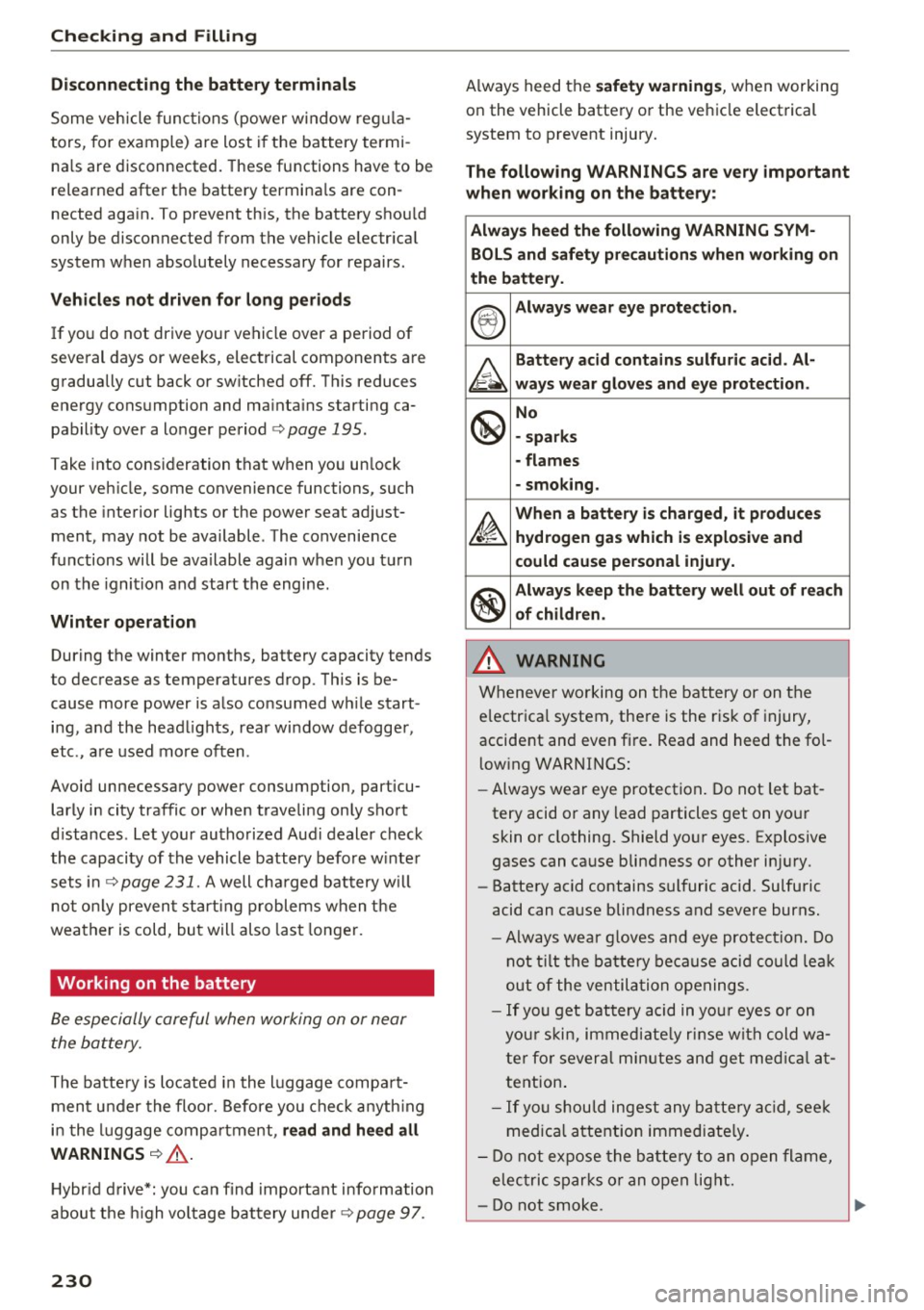
Checking and Filling
Disconnecting the battery terminals
Some vehicle functions (power window regula
tors, for example) are lost if the battery termi
na ls are disconnected. These functions have to be
relearned after the battery terminals are con
nected again. To prevent this, the battery should
only be disconnected from the vehicle e lectrical
system when absolutely necessary for repairs.
Vehicles not driven for long periods
If you do not drive your vehicle over a period of
several days or weeks, electrical components are
gradually cut back or sw itched off. This reduces
energy consumption and ma intains starting ca
pab ility over a longer period
c::> page 195 .
Take into consideration that when you unlock
your veh icle, some convenience functions, such
as the interior lights or the power seat adjust
ment, may not be available. The convenience
functions will be available again when you turn
on the ignition and start the engine.
Winter operation
During the winter months, battery capacity tends
to decrease as temperatures drop. This is be
cause more power is also consumed while start
ing, and the head lights, rear window defogger,
etc., are used more often.
Avoid unnecessary power consumption, particu
larly in city traffic or when traveling only short
d istances . Let your authorized Audi dealer check
the capacity of the vehicle battery befo re winter
sets inc::>
page 231. A well cha rged battery w ill
not only preven t starting problems when the
weather is cold, but will also last longer.
Working on the battery
Be especially careful when working on or near
the battery.
The batte ry is located in the luggage compart
ment under the floor. Before you check anything
in the luggage compartment,
read and heed all
WARNINGS
c::> & .
Hybr id drive*: you can find important information
about the high volta ge battery unde r
c::> page 97.
230
Always heed the safety warnings , when working
on the vehicle battery or the vehicle electrical system to prevent injury.
The following WARNINGS are very important
when working on the battery :
Always heed the following WARNING SYM· BOLS and safety precautions when working on
the battery .
®
Always wear eye protection .
A
Battery acid contains sulfuric acid. Al-
ways wear gloves and eye protection .
@
No
• sparks
• flames
- smoking.
~
When a battery is charged, it produces
hydrogen gas which is explosive and
could cause personal injury.
®
Always keep the battery well out of reach
of children .
.b WARNING
-
Whenever working on the battery or on the
e lectrica l system, there is the risk of injury,
accident and even fire. Read and heed the fol
lowing WARNINGS:
- Always wear eye protection . Do not let bat
tery acid or any lead particles get on your
skin or clothing. Shield your eyes. Explosive
gases can cause blindness or other injury.
- Battery acid contains sulfuric acid. Sulfuric
acid can cause blindness and severe burns.
-A lways wear glo ves and eye protection. Do
not tilt the battery because acid could leak
out of the ventilation openings.
- If you get battery acid in yo ur eyes or on
you r skin, immediate ly rinse with cold wa
ter for several minutes and get medical at
tention .
- If you should ingest any battery acid , seek
medical attention immediate ly.
- Do not expose the battery to an open flame,
elec tric sparks or an open light.
- Do not smoke.
~
Page 244 of 300
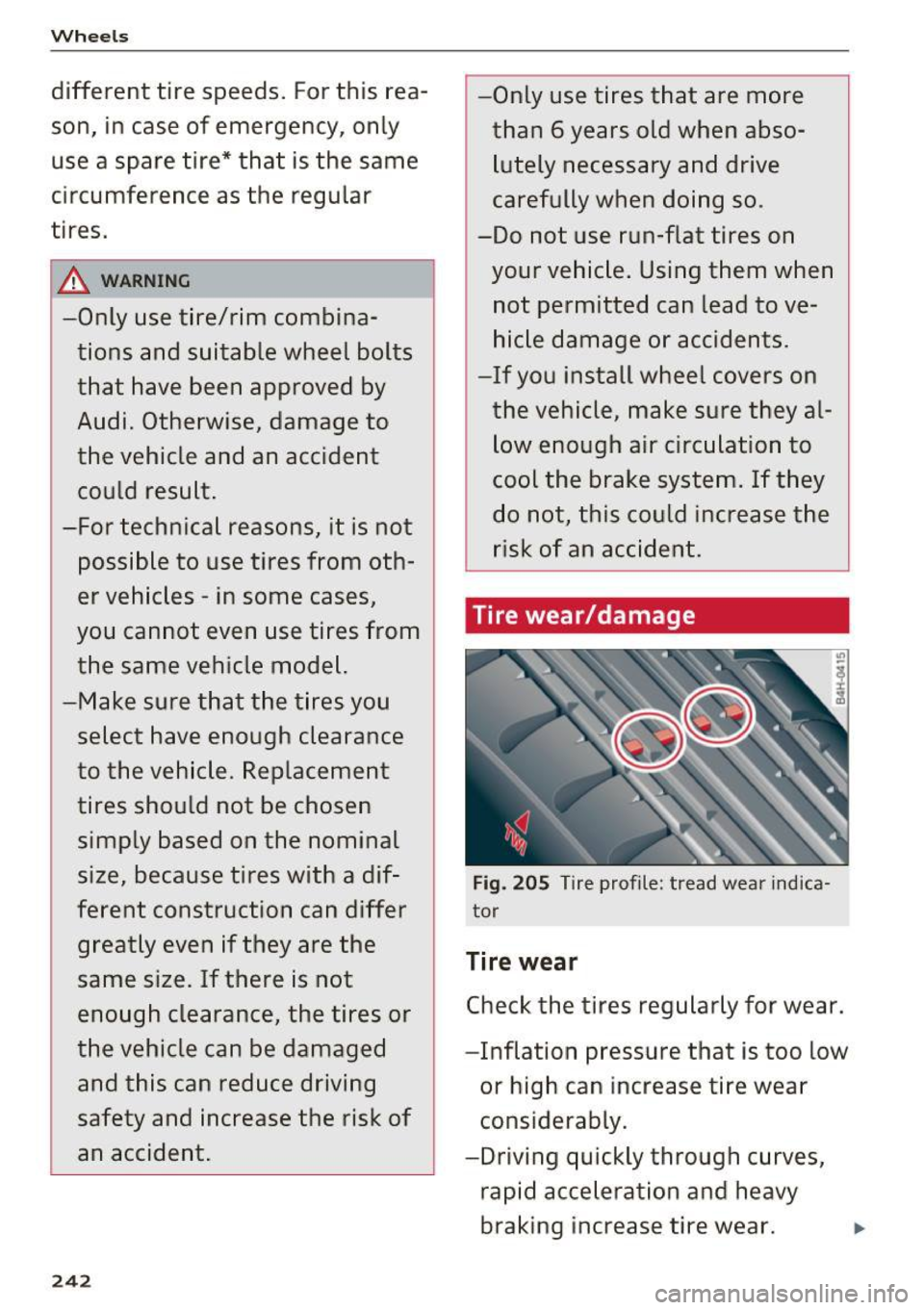
Wheels
different tire speeds. For this rea
son, in case of emergency, only
use a spare tire* that is the same
circumference as the regular
tires.
,&. WARNING -
-Only use tire/rim combina tions and suitable wheel bolts
that have been approved by
Audi. Otherwise, damage to
the vehicle and an accident could result.
-For technical reasons, it is not possible to use tires from oth
er vehicles - in some cases,
you cannot even use tires from the same vehicle model.
-Make sure that the tires you select have enough clearance
to the vehicle . Replacement
tires should not be chosen simply based on the nominal
size, because t ires with a dif
ferent construction can differ
greatly even if they are the
same size. If there is not
enough clearance, the tires or
the vehicle can be damaged and this can reduce driving
safety and increase the risk of
an accident.
242
-Only use tires that are more
than 6 years old when abso
lutely necessary and drive
carefully when doing so .
-Do not use run-flat tires on your vehicle. Using them when not permitted can Lead to ve
hicle damage or accidents.
- If you install wheel covers on
the vehicle, make sure they al
low enough air circulation to
cool the brake system. If they
do not, this could increase the
risk of an accident.
Tire wear/damage
Fig. 205 Tire profile: tread wear ind ica
tor
Tire wear
Check the tires regularly for wear.
- Inflation pressure that is too Low
or high can increase tire wear
considerably.
-Driving quickly through curves, rapid acceleration and heavy
braking increase tire wear. ..
Page 254 of 300
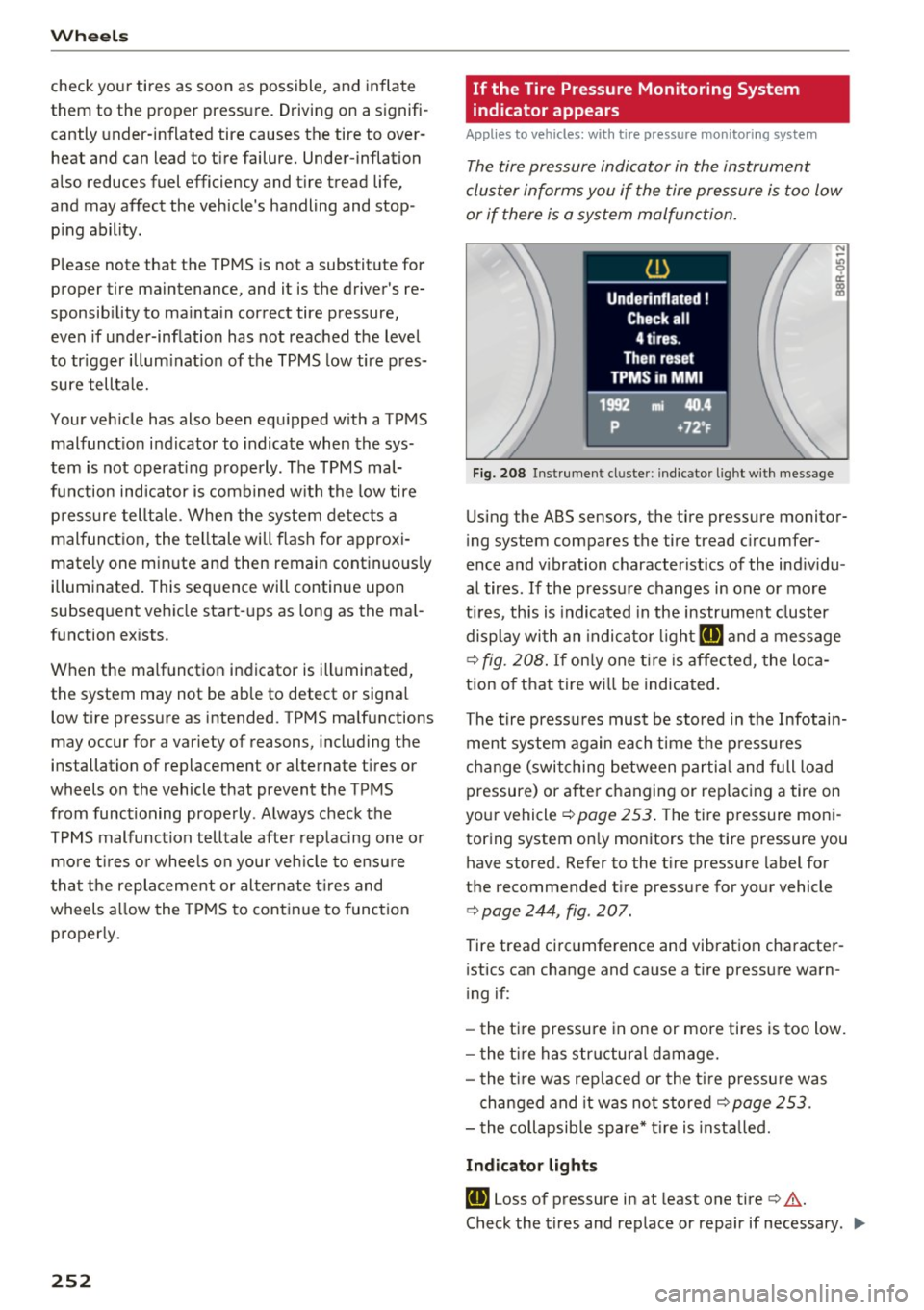
Wheels
check your tires as soon as possible, and inflate
them to the proper pressure. Driving on a signifi
cantly under-inflated tire causes the tire to overheat and can lead to tire failure. Under-inflation
also reduces fuel efficiency and tire tread life,
and may affect the vehicle's handling and stop
ping ability.
Please note that the TPMS is not a substitute for
proper tire maintenance, and it is the driver's re
sponsibility to maintain correct tire pressure,
even if under-inflation has not reached the level
to trigger illumination of the TPMS low tire pres
sure telltale.
Your vehicle has also been equipped with a TPMS malfunction indicator to indicate when the sys
tem is not operating properly. The TPMS mal
function indicator is combined with the low tire pressure telltale. When the system detects a
malfunction, the telltale will flash for approxi
mately one minute and then remain continuously
illuminated. This sequence will continue upon
subsequent vehicle start-ups as long as the mal
function exists .
When the malfunction indicator is illuminated,
the system may not be able to detect or signal low tire pressure as intended . TPMS malfunctions
may occur for a variety of reasons, including the
installation of replacement or alternate tires or
wheels on the vehicle that prevent the TPMS from functioning properly . Always check the
TPMS malfunction telltale after replacing one or
more tires or wheels on your vehicle to ensure
that the replacement or alternate tires and
wheels allow the TPMS to continue to function
properly.
252
· If the Tire Pressure Monitoring System
indicator appears
Applies to vehicles: with tire pressure monitoring system
The tire pressure indicator in the instrument
cluster informs you if the tire pressure is too low
or if there is a system malfunction.
Fig. 208 Instrument cl uster: i ndic ator ligh t with message
Using the ABS sensors, the tire pressure monitor
ing system compares the tire tread circumfer
ence and vibration characteristics of the individu
al tires . If the pressure changes in one or more
tires , this is indicated in the instrument cluster
display with an indicator light
RE and a message
c>fig. 208. If only one tire is affected, the loca
tion of that tire will be indicated.
The tire pressures must be stored in the Infotain
ment system again each time the pressures
change (switching between partial and full load
pressure) or after changing or replacing a tire on
your vehicle
c> page 253. The tire pressure moni
toring system only monitors the tire pressure you have stored. Refer to the tire pressure label for
the recommended tire pressure for your vehicle
c> page 244, fig . 207.
Tire tread circumference and vibration character
istics can change and cause a tire pressure warn
ing if:
- the tire pressure in one or more tires is too low.
- the tire has structural damage.
- the tire was replaced or the tire pressure was
changed and it was not stored
c> page 253 .
-the collapsible spare* tire is installed.
Indicator lights
RE Loss of pressure in at least one tire c> &.
Check the tires and replace or repair if necessary . .,.
Page 256 of 300
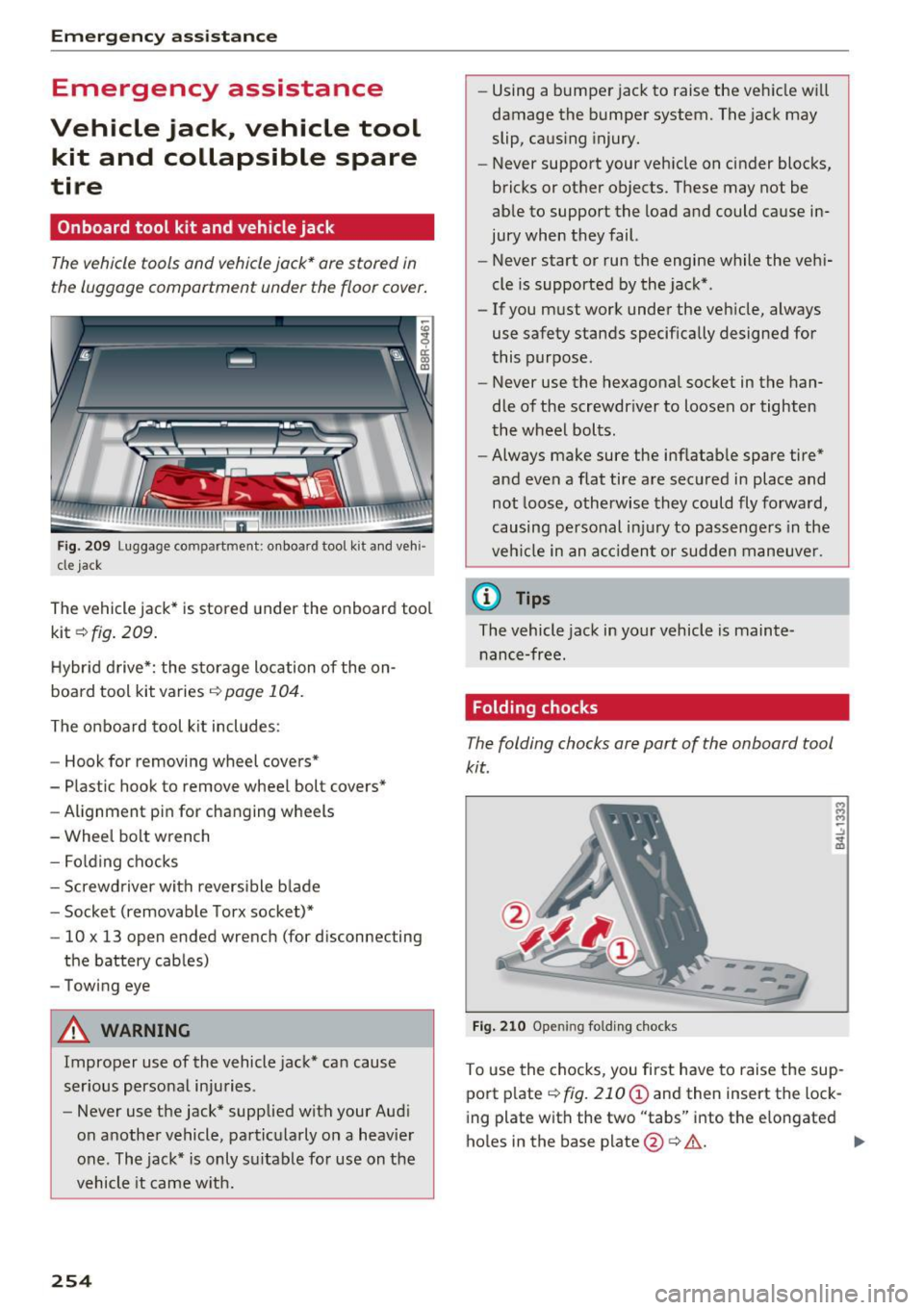
Emerg ency assis ta nce
Emergency assistance
Vehicle jack, vehicle tool kit and collapsible spare
tire
Onboard tool kit and vehicle jack
The vehicle tools and vehicle jock* ore stored in
the luggage comportment under the floor cover.
Fig. 209 Luggage compartment: on board tool kit and vehi
cle jack
The vehicle jack* is stored under the onboard tool
kit ¢ fig. 209.
Hybr id d rive*: the storage location of the on
board tool kit varies ¢ page 104.
The onboard tool k it includes:
- Hook for removing wheel covers*
- Plastic hook to
remove wheel bolt covers*
-Alignment pin for changing wheels
- Wheel bolt wrench
- Folding chocks
- Screwdriver with revers ible blade
- Socket (removable Torx socket)*
- 10 x 13 open ended wrench (for disconnecting
the battery cables)
- Towing eye
A WARNING
Improper use of the vehicle jack* can cause
ser ious personal injuries.
- Never use the jack* supplied with your Aud i
on another vehicle, particularly on a heavier
one. The jack* is only su itable for use on the
vehicle it came w ith.
254 -
Using a bumper jack to raise the vehicle will
damage the bumper system. The jack may
slip, caus ing injury.
- Never support your vehicle on cinder blocks,
bricks or other objects. These may not be
able to support the load and could cause in
jury when they fail.
- Never start or run the engine while the vehi
cle is supported by the jack* .
- If you must work under the vehicle, always
use safety stands specifically designed for
this purpose .
- Never use the hexagonal socket in the han
dle of the screwdr iver to loosen or tighten
the wheel bolts .
- Always make sure the inflatable spare tire*
and
even a flat tire are secu red in place and
not loose, otherwise they could fly forward,
causing personal inj ury to passenge rs in the
vehi cle in an a cc ident or sudden maneuve r.
@ Tips
The vehicle jack in your vehicle is mainte
nance-free.
Folding chocks
The folding chocks ore port of the on board tool
kit .
---
Fig . 210 Open ing fo lding chocks
To use the chocks, you fi rst have to raise the sup
port plate
¢ fig. 210 (D and then insert the lock
ing plate with the two "tabs" into the elongated
holes in the base plate
@ c> &.. .,,_
Page 257 of 300
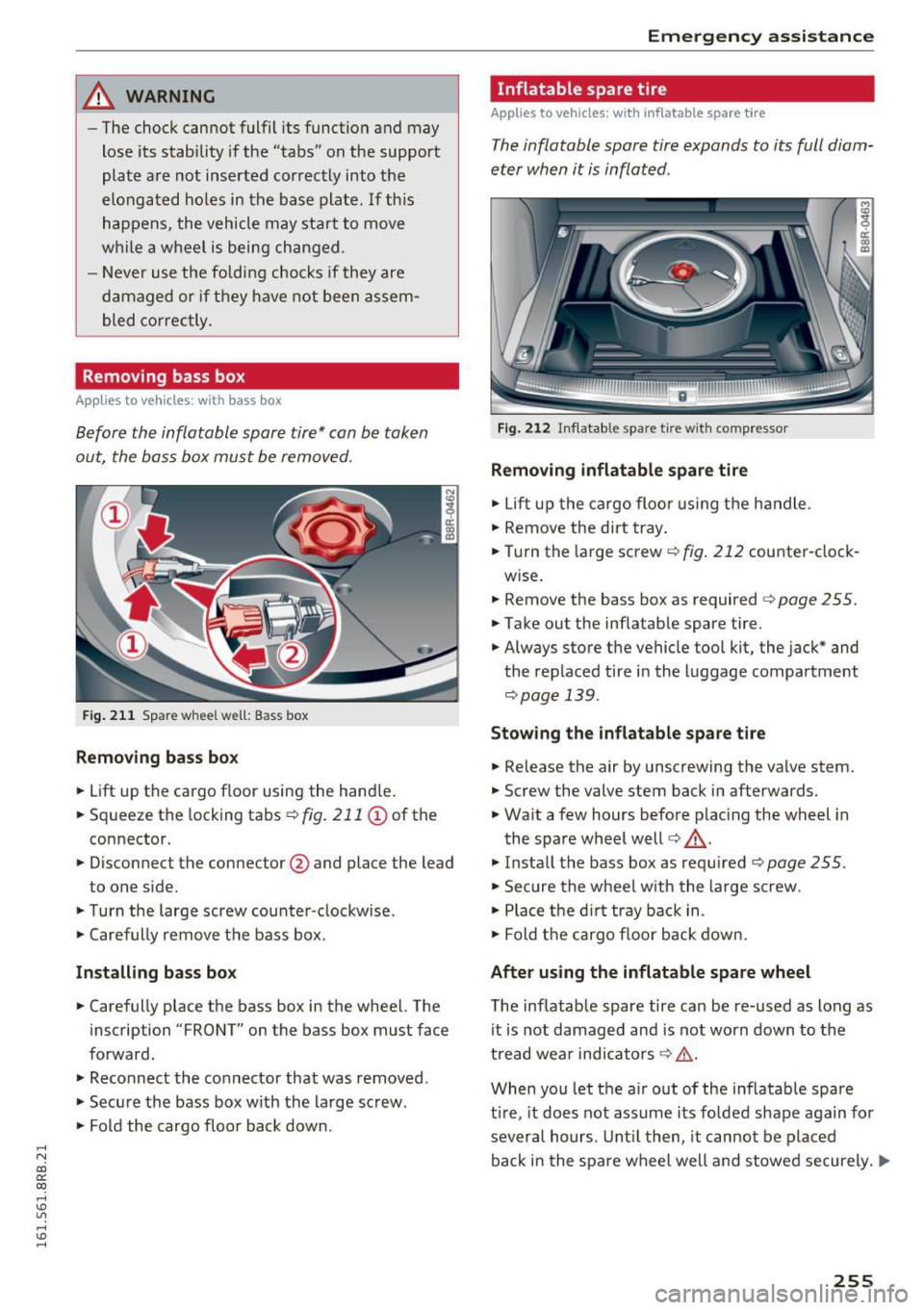
..... N
co ~ CX)
..... I.Cl U"I
..... I.Cl .....
_& WARNING
-The chock cannot fulfil its function and may
lose its stability if the "tabs" on the support
plate a re not inserted correctly into the
elongated holes in the base plate. If th is
happens, the vehicle may sta rt to move
wh ile a wheel is being changed.
- Never use the fold ing chocks if they are
damaged or if they have not been assem
bled co rrectly.
Removing bass box
Appl ies to vehicles : wit h bass box
Before the inflatable spare tire* can be token
out, the bass box must be removed.
Fig . 21 1 Spare w heel well: Bass box
Removing ba ss box
"Lift up the cargo floor using the hand le .
" Squeeze the locking tabs
c:> fig . 211 (D of the
connector.
" Disconnect the connector @and place the lead
to one s ide.
"T urn the large screw counter -clockwise .
" Carefully remove t he bass box .
Installing bas s bo x
"Carefully place the bass box in the whee l. The
inscription "FRONT" on the bass box must face
forward.
" Reconnect the co nnector that was removed.
" Secu re the bass box w ith the la rge screw .
" Fold the cargo floo r bac k down.
Em ergen cy a ssis tanc e
Inflatable spare tire
Applies to vehicles: w ith inflatable spare tire
The inflatable spare tire expands to its full diam
eter when it is inflated .
Fig. 212 In flatable spare tire wit h comp ressor
Removing inflatabl e spare tire
"Lift up the cargo floo r us ing the handle.
" Remove the dirt tray .
" Turn the large screw <=:>
fig. 212 counter -clock-
w ise .
" Remove the bass box as required<=:>
page 255.
"Take out the inflatab le spare tire.
" Always store the vehicle too l kit, the jack* and
the replaced tire in the luggage compartment
<=:> page 139.
Stowing the inflatable spare t ire
.. Release the air by unscrewing the valve stem.
" Screw the valve stem back in afterwards.
" Wa it a few hours before plac ing the wheel in
the spare wheel well<=:>,& .
" Insta ll the bass box as required <=:>
page 255 .
" Secure the whee l w ith the la rge sc rew.
" Place t he d irt tray back in .
" Fold t he c argo floor back down .
After using the inflatable spare wheel
The inflatable spare tire can be re-used as long as
it is not damaged and is not worn down to the
tread wea r indicators
c:> .&, .
When you let the a ir out of the inf latab le spare
t ir e, it does not assume its folded shape again for
severa l hours . Unt il then, it cannot be placed
back i n the spare wheel well and stowed securely.
IJI>
255
Page 268 of 300
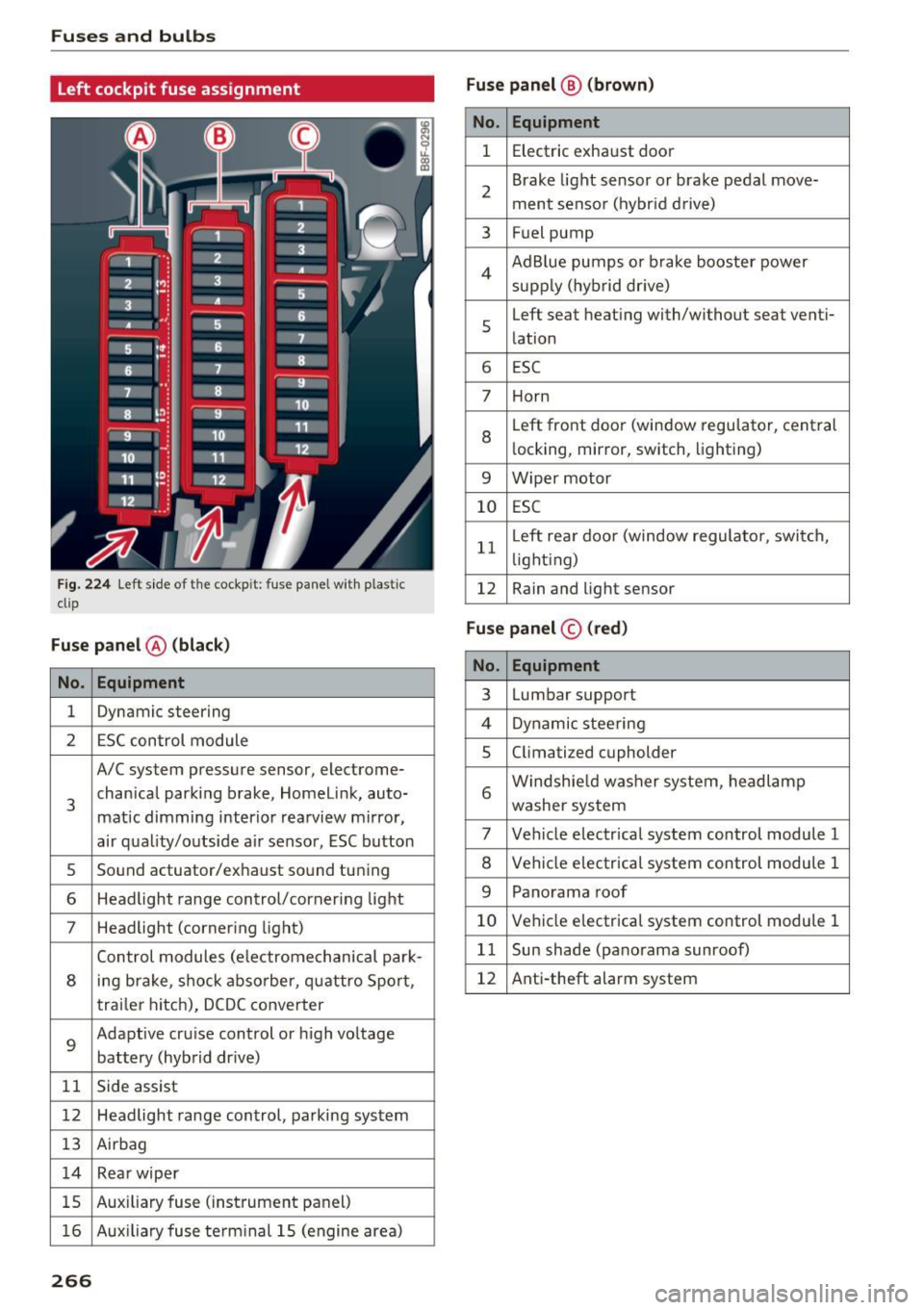
Fuses and bulbs
Left cockpit fuse assignment
Fig. 224 Left side of the cockp it: fuse panel with p lastic
clip
Fuse panel @ (black)
No . Equipment
1 Dynamic steering
2 ESC control module
A/C system pressure sensor, electrome-
3 chanical parking
brake, Homelink, auto-
matic dimming interior rearview mirror,
air quality/outside air sensor, ESC button
s Sound actuator/exhaust sound tuning
6 Headlight range control/corner ing light
7 Headlight (cornering light)
Control modules (electromechanical park-
8 ing brake, shock absorber, quattro Sport,
trailer hitch), DCDC converter
9
Adaptive cruise control or high voltage
battery (hybrid dr ive)
11 Side assist
12 Headlight range control, parking system
13 Airbag
14 Rear wiper
15 Auxiliary
fuse (instrument panel)
16 Auxiliary fuse te rm inal 15 (engine area)
266
Fuse panel ® (brown)
No. Equipment
1 Electric exhaust door
2 Brake
light sensor or brake pedal move-
ment sensor (hybrid drive)
3 Fuel pump
4 Ad
Blue pumps or brake booster power
supply (hybrid dr ive)
s
Left seat heating with/without seat venti-
lation
6 ESC
7 Horn
8
Left front doo r (window regulator, central
locking, mirror, switch, lighting)
9 Wiper motor
10 ESC
11 L
eft rear doo r (window regulator, switch,
li ght ing)
12 Rain and light sensor
Fuse panel
© (red)
No. Equipment
3 Lumbar support
4 Dynamic steering
5 Climatized cupholder
6 Windshie
ld washer system, headlamp
washer system
7 Vehicle electrical system control module 1
8 Vehicle electrical system control module 1
9 Panorama roof
10 Vehicle electrical system control module 1
11 Sun shade (panorama sunroof)
12 Anti-theft alarm system
Page 275 of 300
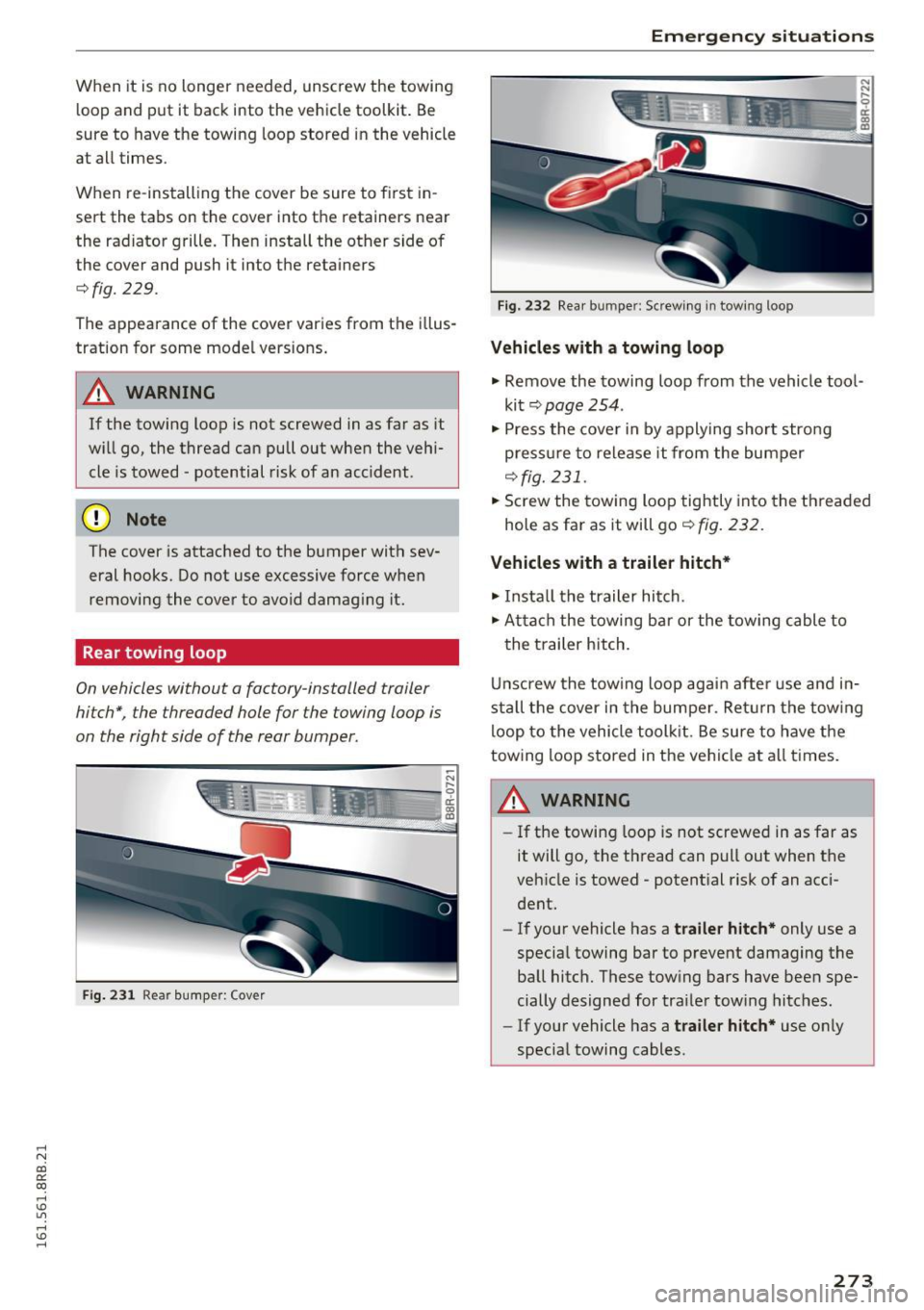
..... N
co ~ CX)
..... I.Cl U"I
..... I.Cl .....
When it is no longer needed, unscrew the towing
loop and put it back into the vehicle toolkit. Be
sure to have the towing loop stored in the vehicle
at all times.
When r e-installing the cover be sure to first in
sert the tabs on the cover into the retainers near
the radiator grille. Then install the other side of
the cover and push it into the retainers
¢fig. 229.
The appearance of the cover varies from the i llus
tration for some model vers ions.
.&_ WARNING
If the towing loop is not screwed in as far as it
will go, the thread can pull out when the vehi
cle is towed -potential risk of an accident.
(D Note
The cover is attached to the bumper with sev
eral hooks. Do not use excessive force when
removing the cover to avoid damag ing it.
Rear towing loop
On vehicles without a factory-installed trailer
hitch*, the threaded hole for the towing loop is
on the right side of the rear bumper.
Fig. 231 Rear bumper: Cover
Emergency situations
Fig. 232 Rear bumper: Screw ing in towing loop
Vehicles with a towing loop
.,. Remove the towing loop from the vehicle tool
kit
c;, page 254.
.,. Press the cover in by applying short stro ng
press ure to release it from the bumper
¢fig. 231 .
.,. Screw the towing loop tightly into the threaded
hole as far as it will go
c;, fig. 232.
Vehicles with a trailer hitch*
.,. Insta ll the trailer hitch.
.,. Atta ch the towing bar or the towing cable to
the trailer hitch.
Unscrew the towing loop again after use and in
stall the cover in the bumper . Ret urn the towing
loop to the vehicle toolkit. Be sure to have the
towing loop stored in the vehicle at all times.
A WARNING
-If the towing loop is not screwed in as far as
it will go, the thread can pull out when the
vehicle is towed - potential risk of an acci
dent.
- If your vehicle has a
trailer hitch* only use a
special towing bar to prevent damaging the
ball hitch. These tow ing bars have been spe
cially designed for trailer tow ing hitches.
- If your vehicle has a
trailer hitch* use only
special towing cables .
273
Page 297 of 300
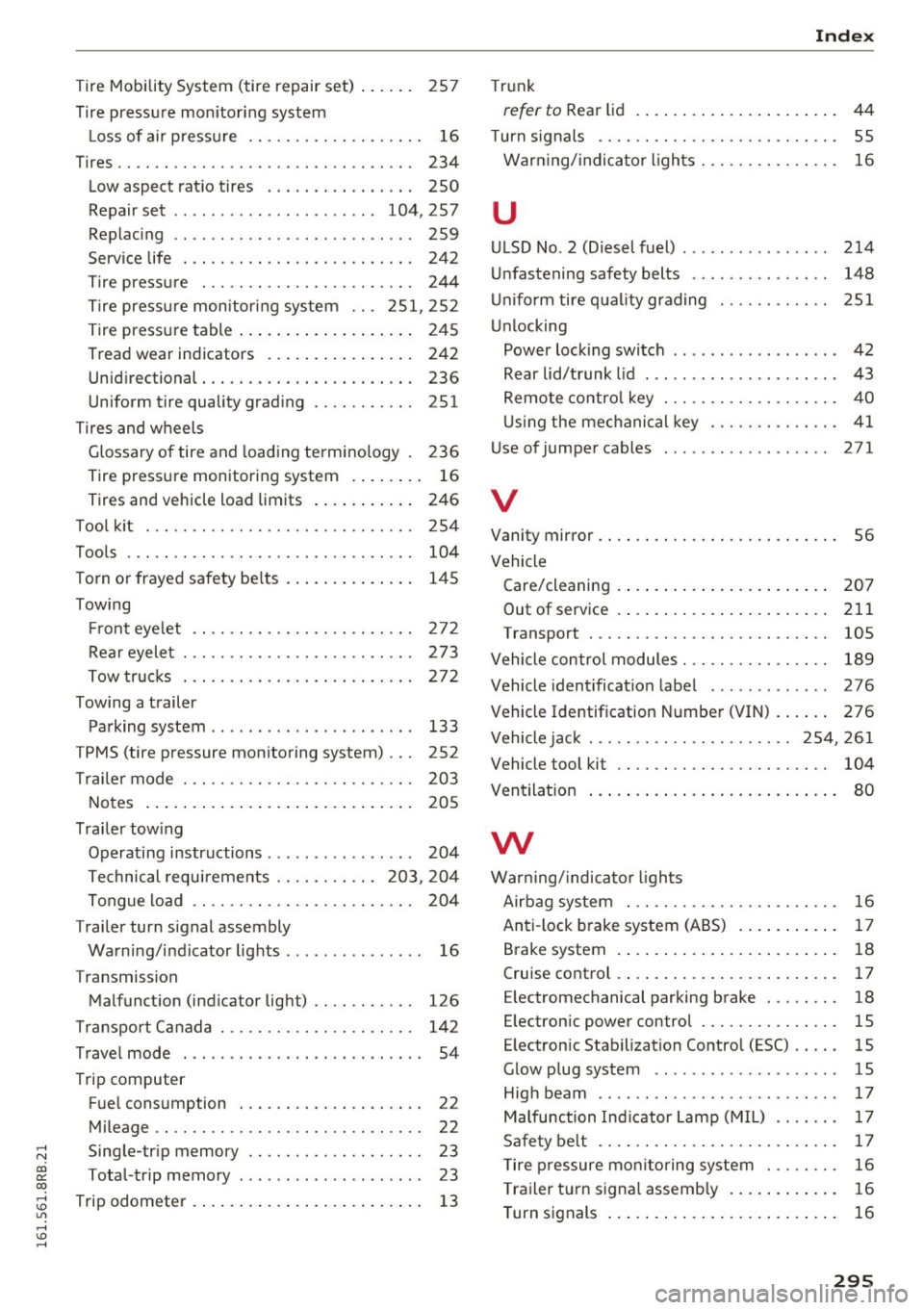
,....,
N
co
er::
co
,....,
Tire pressure monitoring system
L f . oss o a,r pressure . . . . . . . . . . . . . . . . . . . 16
Tires.. .. .. .... ............. .. .. ..... 234
Low aspect ratio tires . . . . . . . . . . . . . . . . 250
Repair set . . . . . . . . . . . . . . . . . . . . . . 104, 257
Replacing . . . . . . . . . . . . . . . . . . . . . . . . . . 259
Service life . . . . . . . . . . . . . . . . . . . . . . . . . 242
r ,re pressure . . . . . . . . . . . . . . . . . . . . . . . 244
Tire pressure monitoring system .. . 251,252
Tire pressure table . . . . . . . . . . . . . . . . . . . 245
Tread wear indicators . . . . . . . . . . . . . . . . 242
Unidirectional . . . . . . . . . . . . . . . . . . . . . . . 236
Uniform tire quality grading .... .. .. .. . 251
Tires and wheels Glossary of tire and loading termino logy . 236
Tire pressure monitoring system . . . . . . . . 16
Tires and vehicle load limits . . . . . . . . . . . 246
Tool kit . . . . . . . . . . . . . . . . . . . . . . . . . . . . . 254
Tools . . . . . . . . . . . . . . . . . . . . . . . . . . . . . . . 104
Torn or frayed safety be lts . . . . . . . . . . . . . . 145
Towing Front eyelet . . . . . . . . . . . . . . . . . . . . . . . . 2 72
Rear eyelet . . . . . . . . . . . . . . . . . . . . . . . . . 273
Tow trucks . . . . . . . . . . . . . . . . . . . . . . . . . 272
Towing a trailer Parking system . . . . . . . . . . . . . . . . . . . . . . 133
T PMS (tire pressure monitoring system) . . . 252
Trailer mode . . . . . . . . . . . . . . . . . . . . . . . . . 203
Notes . . . . . . . . . . . . . . . . . . . . . . . . . . . . . 205
Trailer towing Operating instructions . . . . . . . . . . . . . . . . 204
Technical requirements . . . . . . . . . . . 203 , 204
Tongue load . . . . . . . . . . . . . . . . . . . . . . . . 204
T railer turn signal assembly
Warning/indicator lights . . . . . . . . . . . . . . . 16
T ransmission
Malfunction (indicator light) . . . . . . . . . . . 126
Transport Canada . . . . . . . . . . . . . . . . . . . . . 142
Travel mode . . . . . . . . . . . . . . . . . . . . . . . . . . S4
Trip computer Fue l consumption . . . . . . . . . . . . . . . . . . . . 22
Mileage . . . . . . . . . . . . . . . . . . . . . . . . . . . . . 22
Single-trip memory . . . . . . . . . . . . . . . . . . . 23
Total-trip memory . . . . . . . . . . . . . . . . . . . . 23
Trip odometer . . . . . . . . . . . . . . . . . . . . . . . . . 13
Index
Trunk
refer to Rear lid . . . . . . . . . . . . . . . . . . . . . . 44
T . l urn s1gna s . . . . . . . . . . . . . . . . . . . . . . . . . . 55
Warning/indicator lights . . . . . . . . . . . . . . . 16
u
ULSD No . 2 (Diesel fuel) . . . . . . . . . . . . . . . . 214
Unfastening safety belts . . . . . . . . . . . . . . . 148
Uniform tire quality grading . . . . . . . . . . . . 251
Unlocking Power locking switch . . . . . . . . . . . . . . . . . . 42
Rear lid/trunk lid . . . . . . . . . . . . . . . . . . . . . 43
Remote contro l key . . . . . . . . . . . . . . . . . . . 40
Using the mechanical key . . . . . . . . . . . . . . 41
Use of jumper cables . . . . . . . . . . . . . . . . . . 271
V
V ·t . ani y mirror . . . . . . . . . . . . . . . . . . . . . . . . . . 56
Vehicle Care/cleaning . . . . . . . . . . . . . . . . . . . . . . . 207
Out of service . . . . . . . . . . . . . . . . . . . . . . . 211
Transport . . . . . . . . . . . . . . . . . . . . . . . . . . 105
Vehicle control modules . . . . . . . . . . . . . . . . 189
Vehicle identification label . . . . . . . . . . . . . 276
Vehicle Identification Number (VIN) . . . . . . 276
Vehicle jack . . . . . . . . . . . . . . . . . . . . . . 254, 261
Vehicle tool kit . . . . . . . . . . . . . . . . . . . . . . . 104
Ventilation . . . . . . . . . . . . . . . . . . . . . . . . . . . 80
w
Warning/ indicator l ights
Airbag system . . . . . . . . . . . . . . . . . . . . . . . 16
Anti- lock brake system (ABS) . . . . . . . . . . . 17
Brake system . . . . . . . . . . . . . . . . . . . . . . . . 18
Cruise control . . . . . . . . . . . . . . . . . . . . . . . . 17
Electromechanical parking brake . . . . . . . . 18
Electronic power control . . . . . . . . . . . . . . . lS
Electronic Stabilization Control (ESC) . . . . . lS
Glow plug system . . . . . . . . . . . . . . . . . . . . 15
High beam . . . . . . . . . . . . . . . . . . . . . . . . . . 17
Malfunction Ind icator Lamp (MIL) . . . . . . . 17
Safety belt . . . . . . . . . . . . . . . . . . . . . . . . . . 17
Tire pressure monitoring system . . . . . . . . 16
Trailer turn signa l assemb ly . . . . . . . . . . . . 16
Turn signals . . . . . . . . . . . . . . . . . . . . . . . . . 16
295